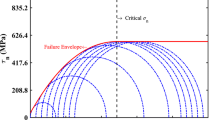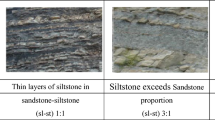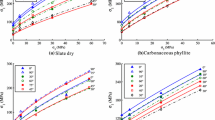Abstract
The extensively used modified anisotropic Hoek–Brown (H-B) failure criterion often overestimates the rock strength under a confining pressure (σ3) exceeding the uniaxial compressive strength (UCS) of rock. In this study, to rectify this problem, the error term (B1σ32) is added to the modified anisotropic H-B strength criterion. The coefficient (B1) in the error term is determined by introducing the anisotropic parameter (kα), and the rock critical confining pressure is adopted for the separation of brittle and ductile rock behaviors. The relationship between the anisotropic parameter (kα) and joint surface dip angle (α) is also established. A new failure criterion that considers rock anisotropy for predicting the rock strength under a high confining pressure (M-HB-HC) is proposed herein. Analyses reveal that the critical coefficient (n) is dependent of the angle (α) and parameter (kα). The strength predictions for different types of rocks using four failure criteria were compared under four confining pressure conditions. The comparison shows that the M-HB-HC failure criterion has better accuracy than other failure criteria; it can describe the transformation from brittle to ductile behaviors of rock as confining pressures increase. Furthermore, we used discrete element numerical software (3DEC) to conduct nine groups of numerical simulations of triaxial confining pressure tests to verify the accuracy of the criterion. The results of the numerical simulation are in good agreement with the experimental data. The M-HB-HC failure criterion is more suitable for rocks with one set of joint surfaces.












Similar content being viewed by others
Data availability
All data, models, or codes generated or used during the study are available from the corresponding author upon request.
Abbreviations
- β (°):
-
Angle between the loading direction and plane of anisotropy
- β m (°):
-
Angle describing minimum uniaxial compressive strength
- α (°):
-
Joint surface dip angle
- α β :
-
Reduction factor of strength associated with rock anisotropy
- k β :
-
Anisotropic parameter considering angle β
- k α :
-
Anisotropic parameter considering angle α
- σ ci (MPa):
-
Uniaxial compressive strength
- σ ci ,β (MPa):
-
UCS, which depends on angle β
- σ ci ,α (MPa):
-
UCS, which is dependent on the joint surface dip angle α
- σ 1 j (MPa):
-
Maximum principal stress limit value of joint surface friction force when β is equal to \(\frac{\pi }{4}-\frac{{\varphi }_{j}}{2}\)
- σ ccp (MPa):
-
Critical confining pressure
- σ ci ,αmax (MPa):
-
Maximum uniaxial compressive strength considering joint surface dip angle α
- σ ci ,αmin (MPa):
-
Minimum uniaxial compressive strength considering joint surface dip angle α
- σ 1 (MPa):
-
Major principal stress
- σ 1-σ 3 (MPa):
-
Deviatoric stress
- σ 3 (MPa):
-
Minor principal stress
- σ cr :
-
Critical confining pressure in Zhang’s new I-HB-MW failure criterion
- c j :
-
Cohesive force on the joint surface
- μ j :
-
Friction coefficient of the joint surface
- φ j (°):
-
Internal friction angle on the joint surface
- B 1 σ 3 2 :
-
Error term
- B 1 :
-
Coefficient in the error term and a constant related to rock type
- ω :
-
Relative error (%)
- n :
-
Critical coefficient of the rock
- s :
-
Rock mass material constant of Hoek–Brown failure criterion
- s an :
-
Rock mass material constant of Hoek–Brown failure criterion
- s θ :
-
Rock mass material constants in Lee’s failure criterion
- m i :
-
Dimensionless empirical parameter of Hoek–Brown failure criterion
- m p :
-
Dimensionless empirical parameter with angle β of Saroglou’s modified Hoek–Brown failure criterion
- m b,an :
-
Reduced value of mi parameter for anisotropic rock mass
- m θ :
-
Rock mass material constant in Lee’s failure criterion
- ζ :
-
Rock mass material constant of Hoek–Brown failure criterion
- ζ m :
-
Value of angle β at minimum mp
- ζ s :
-
Value of angle β at the minimum s
- r :
-
Strength reduction factor defined by Saeidi et al. (2013)
- A :
-
Parameter related to the rock shear shrinkage failure
- R c :
-
Index of anisotropic rocks strength degree
- a m 1;2 :
-
Coefficient in Lee’s failure criterion
- a s 1;2 :
-
Coefficient in Lee’s failure criterion
- Ωs 0 :
-
Second-order tensors in Lee’s failure criterion
- Ωm 0 :
-
Second-order tensors in Lee’s failure criterion
- a,b :
-
Experiment constants in Chen’s deviatoric stress–strain condition
- d :
-
Exponent in the error term (B1σ3d)
- θ :
-
Exponent in the expression of mp
- ξ :
-
Exponent in the expression of s
- A2, A 3 :
-
Material constants in the expression of θ
- p2, p 3 :
-
Material constants in the expression of ξ
- Q, W :
-
Constants in the expression of σci,β
- Q 1, Q 2, W 1, and W 2 :
-
Constantsin McLamore and Gray’sexpression
- t, o :
-
Positive integers exponentsin McLamore and Gray’sexpression
- β t :
-
Angle corresponding to the minimum uniaxial compressive strength
- τ :
-
Shear stress
- c :
-
m p k α
- d :
-
c+(c2+54)0.5
- f :
-
4d(cd+27)0.5/(27)0.5σci,α
References
Barton N (1976) The shear strength of rock and rock joints. Int J Rock Mech Min Sci Geomech Abstr 13(9):255–279
Bar N, Saroglou C (2020) The ARMR classification system and the modified Hoek-Brown failure criterion compared to directional shear strength models for anisotropic rock masses. Period Polytech Civ Eng 64(1):14–19
Behrestaghi MHN, Rao KS, Ramamurthy T (1996) Engineering geological and geotechnical responses of schistose rocks from dam project areas in India. Eng Geol 44(1–4):183–201
Bieniawski ZT (1989) Engineering rock mass classifications: a complete manual for engineers and geologists in mining, civil, and petroleum engineering. John Wiley & Sons, New York, p 127
Brady BHG, Brown ET (1981) Energy changes and stability in underground mining: design applications of boundary element methods. Instit Min Metall Trans 90:A61–A68
Byerlee J (1978) Friction of Rocks. Pure Appl Geophys 116:615–626
Chen Q, Yang C, Zhang C et al (2019) Mechanical behavior and particle breakage of tailings under high confining pressure. Eng Geol 265(1–2):105419
Drucker DC, Prager W (1952) Soil mechanics and plastic analysis or limit design. Q Appl Math 10(2):157–165
Donath FA (1961) Experimental study of shear failure in anisotropic rocks. Geol Soc Am Bull 72(6):985–989
Donath FA (1964) Strength variation and deformation behavior in anisotropic rock. In: Judd WR (ed) State of stress in the earth’s crust. Elsevier, New York, pp 281–297
Donath FA (1972) Effects of cohesion and granularity on deformational behavior of anisotropic rock. Geol Soc Am Mem 135:95–128
Griffith AA (1921) The phenomena of rupture and flow in solid. R Soc 221(582):163–198
Guo S, Qi S, Huang X (2013) Anisotropy of rock mass strength and its transformation critical confining stress. Chin J Rock Mech Eng 32(S2):3222–3227 (In Chinese)
Hoek E, Brown ET (1980) Underground excavations in rock. CRC Press, London
Hoek E (1983) Strength of Jointed Rock Masses. Géotechnique 33(3):187–223
Hoek E, Brown ET (1997) Practical estimates of rock mass strength. Int J Rock Mech Min Sci 34(8):1165–1186
Hoek E, Marinos P, Benissi M (1998) Applicability of the geological strength index (GSI) classification for very weak and sheared rock masses. The case of the Athens Schist Formation. Bull Eng Geol Environ 57(2):151–160
Ismael MA, Imam HF, El-Shayeb Y (2014) A simplified approach to directly consider intact rock anisotropy in Hoek-Brown failure criterion. J Rock Mech Geotech Eng 6(5):486–492
Ismael MA, Konietzky H (2019) Constitutive model for inherent anisotropic rocks: Ubiquitous joint model based on the Hoek-Brown failure criterion. Comput Geotech 105:99–109
Jaeger JC (1960) Shear failure of anisotropic rocks. Geol Mag 97(1):65–72
Lade PV (1977) Elasto-plastic stress-strain theory for cohesionless soil with curved yield surfaces. Int J Solids Struct 13(11):1019–1035
Lee YK, Pietruszczak S (2007) Application of critical plane approach to the prediction of strength anisotropy in transversely isotropic rock masses. Int J Rock Mech Min Sci 45(4):513–523
Li B, Xu MG, Liu YZ et al (2015) Modified Hoek-Brown strength criterion for intact rocks under the condition of triaxial stress test. J Min Saf Eng 32(06):1010–1016 (In Chinese)
Li B, Xu MG, Liu YZ (2016) Application of critical state confining pressure to rock strength criteria modification. Rock Soil Mech 37(2):390–398 (In Chinese)
Mclamore RT, Gray KE (1967) The mechanical behavior of anisotropic sedimentary rocks. J Eng Ind 89(1):62–73
Mohr O (1900) Welche Umstände bedingen die Elastizitätsgrenze und den Bruch eines Materials. Z Ver Dtsch Ing 46(1524–1530):1572–1577
Ramamurthy T (1993) Strength and modulus responses of anisotropic rocks. Compr Rock Eng 1:313–329
Saeidi O, Vaneghi RG, Rasouli V et al (2013) A modified empirical criterion for strength of transversely anisotropic rocks with metamorphic origin. Bull Eng Geol Env 72(2):257–269
Saroglou H, Tsiambaos G (2008) A modified Hoek-Brown failure criterion for anisotropic intact rock. Int J Rock Mech Min 45(2):223–234
Saroglou C, Qi S, Guo S et al (2019) ARMR, a new classification system for the rating of anisotropic rock masses. Bull Eng Geol Environ 78(5):3611–3626
Singh M, Raj A, Singh B (2011) Modified Mohr-Coulomb criterion for non-linear triaxial and polyaxial strength of intact rocks. Int J Rock Mech Min Sci 48(4):546–555
Shi XC, Meng YF, Li G (2011a) Comparative analyses of several rock strength criteria. Rock Soil Mech 32:209–216 (In Chinese)
Shi XC, Yang X, Meng YF (2016) Modified Hoek-Brown failure criterion for anisotropic rocks. Environ Earth Sci 75(11):1–11
Shi C, Jiang XX, Zhu ZD et al (2011b) Study of rock damage constitutive model and discussion of its parameters based on Hoek-Brown criterion. Chin J Rock Mech Eng 30(1):2647–2652 (In Chinese)
Stagg KG, Zienkiewica OC (1983) Rock Mechanics in engineering practice. Wiley, New York, pp 99–124
Xu SL, Wen WU, Wang GY et al (2001) Study on complete procedures of marble under triaxial compression I: testing study on complete procedure of triaxial compression ang the processes of unloading confining at the pre-peak and post-peak. Chin J Rock Mech Eng 20(06):763–767 (In Chinese)
Yang YG, Gao F, Lai Y (2013) Modified Hoek-Brown criterion for nonlinear strength of frozen soil. Cold Reg Sci Technol 86:98–103
Yang SQ, Su CD, Xu WY (2005) Experimental investigation on strength and deformation properties of marble under conventional triaxial compression. Rock Soil Mech 26(3):475–478 (In Chinese)
Zhang J, Ren F, He R et al (2022) Research on the applicability of rock critical state confining pressure under conventional triaxial compression conditionss. Chin J Min Saf Eng 39(01):154–162 (In Chinese)
Funding
This study was supported by the National Natural Science Foundation of China (Nos. 51774018, 12172036), BUCEA Doctor Graduate Scientific Research Ability Improvement Project (Nos. DG2021003), BUCEA Post-Graduate Innovation Project (Nos. PG2021007), and Program for Changjiang Scholars and Innovative Research Team in University (PCSIRT,IRT_17R06).
Author information
Authors and Affiliations
Corresponding author
Ethics declarations
Conflict of interest
The authors declare no competing interests.
Rights and permissions
About this article
Cite this article
Wang, Z., Qi, C., Ban, L. et al. Modified Hoek–Brown failure criterion for anisotropic intact rock under high confining pressures. Bull Eng Geol Environ 81, 333 (2022). https://doi.org/10.1007/s10064-022-02831-8
Received:
Accepted:
Published:
DOI: https://doi.org/10.1007/s10064-022-02831-8




